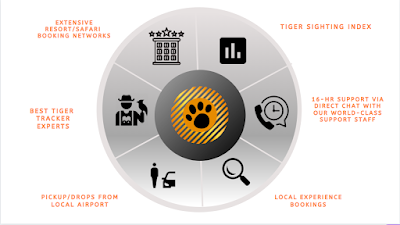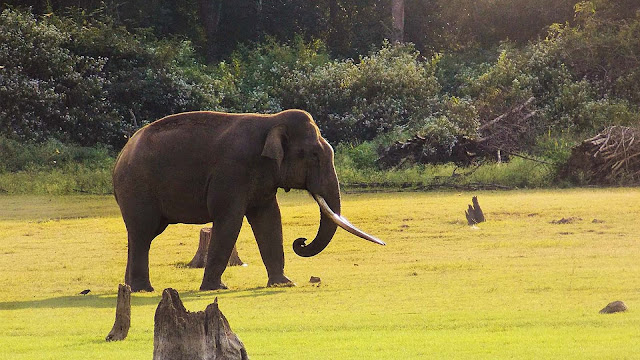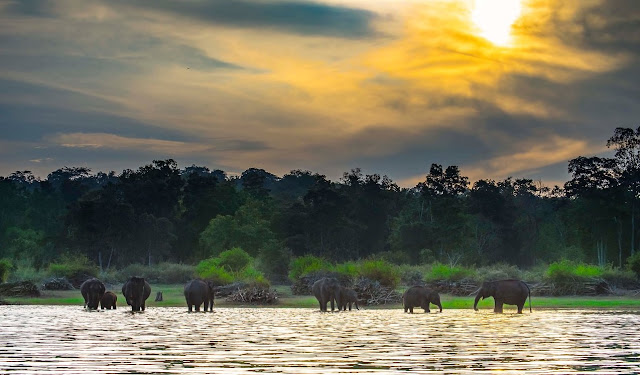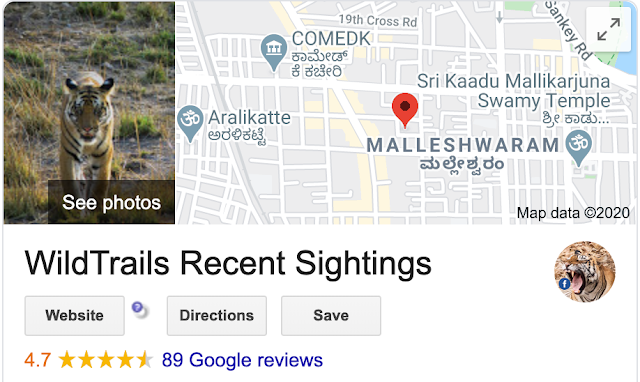How To Book Safari Online At Ranthambore National Park
Ranthambore Tiger Reserve, before a significant game conserve is the scene where the celebrated Indian Royal Bengal Tiger is finest seen. Ranthambore Tiger Reserve lies on the junction of Aravali valley and Vindhyas just 14 Kilometer from Sawai Madhopur district in Eastern Rajasthan. It sprawls over a varying and undulating landscape. The scenery changes significantly from gentle and steep slopes of the Vindhyas and sharp and conical hills of the Aravali valley. A tenth century fort also blends amicably with the background. Pure sands of Dhok tree (Anogeissus pendula) interspersed with grasslands at the plateaus; meadow in valleys and luxuriant foliage around the canals makes the jungle. Three big lakes – Malik Talab, Raj Bagh and Padam Talab – are similar turquoises studded in the vast jungle that abounds with water vegetation including duckweeds, lilies and lotus.

A major environmental feature within the Ranthambore Tiger Reserve or Ranthambore National Park is the 'Great Boundary error where the Vindhyas plateau meets the Aravali range. The Rivers Chambal in the South and the Banas River in the North bound the tiger reserve. The reserve is dotted with steep rocky hills and the dominate architecture of Ranthambore Fort (built in the 10th era), adds to its landscape. The rugged park landscape alternates between dry deciduous jungle, open grassy meadow, dotted by numerous lakes and rivers that are only made passable by rough roads build and maintain by the Forest Department. The Royal Bengal Tiger is not the only attraction at Ranthambore National Park although it is the one park resident that people come to see many and of other animals and birds like hyena, jackal, bear, deer and leopard etc.
Book Safari To Ranthambore National Park
Confirm your Ranthambhore safari booking today With WildTrails, and get a chance to spot the tiger in Ranthambhore Tiger Reserve With the help of WildTrails Sighting Index, where the report is separated according to Parks, Mammals, Birds. The park lies at a plateau, and is sealed to the north by the Banas River and to the south by the Chambal River. There are several lakes in the reserve. It is named for the historic Ranthambhore fort, which is also situated in the tiger reserve. The tiger reserve covers an area of 392 km, and is famous for its tiger population, and is one of India's Project Tiger reserves. the major wild animals include the tiger, sambar, nilgai, dholes, sloth bear, wild boar, leopard, hyena and chital. It is also home to a wide assortment of trees, plants, birds and reptiles. Ranthambhore National Park also has the one of the biggest banyan trees in India.
There are two kinds of vehicles permitted into Ranthambore Tiger reserve-
- 4 wheel drive jeeps (which seat up to 6 visitors) and 16 or 20 seater Canters (open top roof buses).There are a limited number of vehicles allowed into the park, a maximum of 40 vehicles, 17 jeeps for tourist and 3 jeeps for VIP and 20 Canters at any one time. All these vehicles are taken on tender by the Forest Department and owned and run by local natives.Vehicles that are not attached to the forest department are not permitted into the park. Gypsies and Canters are booked in advance and visitors are strongly advised to booking their safaris in advance.specially if you want to book gypsy then make the booking at least 90 days before

- Canter Safari in Ranthambhore Tiger Reserve Canter safari is the very enjoyable style to watch the exotic wildlife. Most of the peoples specially big groups prefer to go on Canter safari. At a time Canter safari can accommodate 16-21 people. It gives personal pleasure of sightseeing and the exclusive experience of exploring the superb scenes of the reserve. The safari can be enjoyed in two different times-either early in the sunrise or in the late afternoon with the current environment.
Jeep Safari in Ranthambhore Tiger Reserve Jeep Safari in Ranthambhore is one of the most popular options to spot animal faction and admire the beautiful shots of the park. Jeeps are open which can accommodate up to 6 people at a time. You can enjoy the personalized and enrich experience of jeep safari in Ranthambore either in the morning or in the afternoon with the current environment.
Checkout Ranthambore Tour Package
Sloth bear VS Tiger | Sloth Bear Charges Two Tigers |Ranthambore National Park | Wildtrails
Be Lucky Yourself To Capture this kinds of Encounters Between Animal
Book With WildTrails For Confirmed Sightings
WildTrails provides an easy way of seeing all possible wildlife trips for some of the top exotic wildlife destinations across the world [Currently Supporting India, Kenya & Tanzania] with an end-to-end trip right from your flights, to wildlife resorts to wildlife safaris to pickup/drops from local airports to even local experiences & that you probably don’t want to miss including 16-hr support via direct chat with our world-class support staff via our App or WhatsApp (in the event of any delays or last-minute issues to any general queries about your plan or destination).
WildTrails uses the network of best tiger tracker experts associated with the particular zone of the park.
WildTrails is the world’s first and only company to bring Sightings Data, analytics into planning Wildlife holidays. WidTrails have all the sightings info (4 years data) to create a predictive metric called the sighting index.
Book Your Jeep and Canter Safari To Ranthambore Tiger Reserve

Our Trails Across India
- Kabini
- Nagarahole national park
- Bandipur National park
- Bandhavgarh National Park
- Kaziranga National Park
- Ranthambore National park
- Thadoba Andhari tiger reserve
- Gir Forest National park
- Jim-Corbett National park
- Pench Wildlife Sanctuary
- Kanha National Park & Many more
Our Trails Across Africa
- Masai Mara National Reserve
- Serengeti National Park
- Kruger National Park
wildlifesafari.hatenadiary.com
Know About Ranthambore National Park
Ranthambore National Park
Ranthambore National Park is located at a distance of 158 km from Jaipur in the Sawai Madhopur district of Southeastern Rajasthan. It covers an area of about 392 sq km, surrounded by other sanctuaries like Mansingh Sanctuary & Kaila Devi Sanctuary. It is the biggest National Park in Northern India and one among the prominent Wildlife tourist spots of India.
With its rich flora and fauna, varied species of animals & birds and unique wilderness can be considered as a treat for many wildlife lovers and photographers. It is known to be the best tiger spotting location of India as the park is majorly inhabited by the royal predators.
Book Jeep Safari At Ranthambore National Park

Flora of Ranthambhore National Park
Ranthambore National Park is enriched with flora. With plenty of water support around 300 species of plant are grown in the Ranthambore National Park. This region is close to the Thar, as a result, it receives inadequate rainfalls and therefore the vegetation in the park is majorly dry deciduous type. About 80% of the vegetation in the park is 'Dhok' (Anogeissus pendula) which is found on hill slopes and valleys.
The park comprises of the trees like Am (Magnifera iIndica), Imli (Tamarindicus indica), Babul (Accasia nilotica), Banyan (Ficus benghalensis), Ber (Zizyphus mauritiana), Dhak or Chila (flame of the forest) {Butea monosperma}, Dhok (Anogeossis pendula), Jamun (Syzygium cumini), Kadam (Authocephalus cadamba), Khajur (Phoenix sylvestris) and Khair (Accacia catechu).
Ranthambore forests have contrasting vegetation such as Karel (Capparis decidua), Khejda (Prosopis specigera), Kakera (Flacourtia indica), Mohua (Madhuca indica) and Neem (Azadirachta indica). Ranthambore National Park also has a variety of aquatic flora such as water lilies and lotus.
Fauna of Ranthambhore National Park
The unusual climate and vegetation of Ranthambhore made the forests dry and left with little and underdeveloped ground. Therefore, viewing of wildlife becomes easier in Ranthambore National Park through safari. It is also known as a virtual island, rich in fauna.
Tigers are solitary by nature and the park is frequented for spotting tigers, which is almost a matter of luck. The evidences of tiger’s activities are also very exciting.
Leopard, Jungle cat, Fishing cat, Caracal and different kinds of cats are found in Ranthambore. Other predators such as Sloth Bear, Jackal, Striped Hyena, Palm civet, Desert fox, crocodile, common mongoose, python, etc. Varied species of deer like antlers (two kinds), sambhar, chital (spotted deer) and antelopes (two kinds), nilgai or bluebull and chinkara or Indian Gazelle are also found in Ranthambore.
Crocodiles can be seen basking around the lakes, serpent eagles, vultures and waterfowl along with 300 species of birds including large Cormorant, Sarus Crane, Painted Spurfowl, Sandpiper, Bronzed winged Jacana, Kingfisher, Painted Sandgrouse, Nightjar, Great horned owl and other migratory which comes to Ranthambore and surrounding areas, will enhance the wildlife experience of the visitors. Ranthambore is an ideal place for bird watchers, nature lovers and wildlife photographers and seems to be a paradise for them
.

Climate of RanthambhoreBest Time to Visit Ranthambhore National Park
Ranthambore National Park has dry sub-tropical climate. The three major seasons are summer, winter and monsoon.
Summer :
In Ranthambore, summer begins from the end of March and last till June. During this summer the days remain hot and dry with themaximum day temperature above 40°C. At night the temperature drops to 30°C. During the day, one can experience loo.
Monsoon :
Ranthambore experiences monsoon from July to September. The weather remains humid and receives two thundershowers a week. From ten to fifteen days the land of Ranthambore does not receive any rain. Therefore, areas in and around Ranthambore suffers from droughts.
Winter :
The winter months begins in Ranthambore from November to February, when the night temperature goes below 10°C, while the day temperature raises up to 20°C. The mid-winter is supposed to have rain and fog. During winters, the mornings in Ranthambore national park remains very cold.
Best Time to Visit Ranthambore National Park:
It is recommended to visit the park between October and June to enjoy at the fullest.
Conservation History of Ranthambore
Ranthambore National Park is named after the fort standing in the middle of the forests. The name of the fort was originated from two hills – Thanbhor and Ran. The fort was built on the Thanbor hill and the other hill called Ran is at the back of the fort.
1970 : Ranthambore was earlier the hunting reserve of the Maharajas of Jaipur. They continued hunting even after it was declared a sanctuary in 1970 till hunting was banned in the same year.
1955 : It was declared as Sawai Madhopur Wildlife Sanctuary.
1960 : Queen Elizabeth II of England along with H.R.H Duke of Edinburgh visited Ranthambore in the year 1960 for a royal hunt, as guests of the Maharaja of Jaipur.
1973 : Tiger Project was launched on April 1, 1973 in which nine tiger reserves were chosen including Ranthambore.
1981 : Ranthambore was declared as National Park in 1981.
1981 and 1990/1991 : Between the year 1981 and 1990 or 1991 the villages were relocated outside the Ranthambore National Park. At the same time, the tiger population gradually started to increase and even new generation of tigers were born to tigresses.
1989 : After the project Tiger was introduced, the census revealed 44 tigers in 1989 from a mere count of 14.
1992 : There was a drop in the tiger population as the census showed only 15-20 tigers. The census gave an idea that the tigers were being poached in the East market, for their bones.
2002 to 2003 : An increase in the count of tiger population was found in the year 2002 to 2003 as strict protection was given to the predators.
2005 : India went through its Third Tiger Crisis as the population dropped from 47 to 26. It was presumed that 21 tigers were being poached as they were missing.
Two tigers fight to death over female | Tigers Fight For Territory | Fight Between Two Tigers
Why WildTrails
WildTrails is the world’s first and only company with Sightings Info (with 4 years data), analytics & predictability into planning Wildlife holidays. WidTrails have all the sightings info (more than 4 years of data) to create a predictive metric called the Sighting Index. WildTrails uses Artificial Intelligence to maximize the chances of Wildlife (Tiger, Leopard, Black Panther ) sightings.
WildTrails uses the network of best tiger tracker experts associated with the particular zone of the park.
WildTrails has sighting information from across all National Parks.
Other Indian Parks We Are Into
Kabini
Nagarahole national park
Bandipur National park
Kaziranga National Park
Ranthambore National park
Thadoba Andhari tiger reserve
Gir Forest National park
Jim-Corbett National park
Pench Wildlife Sanctuary
Kanha National Park & Many more
African Parks We Are Into
Masai Mara National Reserve
Naivasha National Park
Kruger game Reserve
Serengeti National Park & Others
Feel free to Contact Us
Call: +91 9901175444
Mail : info@wildtrails.co

Complete Guide for Nagarhole National Park
- Veeranahosahalli (near Hunsur)
- On the northern side and Nanachi (near Kutta)
- On the western side towards Coorg,
- Antharasanthe (near Kabini) on the eastern side towards Mysore. It takes about an hour to drive between them.
- Nagarahole national park
- Bandipur National park
- Kaziranga National Park
- Ranthambore National park
- Thadoba Andhari tiger reserve
- Gir Forest National park
- Jim-Corbett National park
- Pench Wildlife Sanctuary
- Kanha National Park
- African Parks& Many more
Things To Know About Nagarhole National Park
History of Nagarhole:
Geography of Nagarhole:
Safari gates near Nagarhole:
Learn more about Nagarhole Safari?
Sightings of Nagarhole:
Play with WildTrails intelligence graphs:
Resorts of Nagarhole:
What are the best ways to get to Kabini National Park?
But why do you want to go to Kabini? Why not -
Black panthers, Tigers, Leopards, elephants, deers, sambar deer, dholes, mongoose and plethora of birds - get best sightings of them.
Still not convinced why go to Kabini? then lo ! - You have nature - Kabini is located on the banks of river Kabini/Kapila. Kabini offers breathtaking nature views. Kabini river presents itself with Boat safaris.
Kabini is rich in wildlife, the diversity of wild animals is amazing, it's open around the year (most parks in India close for approx 3 months during monsoon), it's wildlife photographers heaven for the kind of shots you get there. Are you convinced yet?
Its only 3hr drive from Bangalore, and 1hr drive from Mysore, why not just get away on weekends?
But how to find Black Panther in Kabini? Wildtrails published this Black Panther research in Times of India.
By flight
The nearest airports are in Bangalore
By rail
The nearest station is in the city of Mysore.
By road
The park is well connected by roads and distances with various cities can be calculated as follows: Madikeri (138 km), Mysore (77 km) and Bangalore (227 km)
From Mysore, either get a Taxi/Cab or get onto any Bus that goes to Manatvadi (Kerala) (Either Karnataka State Transport or Kerala State Transport (and supposed be every ½ hr) and get down at Karapura and call your respective Resort and they will come and pick you up.
How to reach safari point?
To go to Damankatte gate (Antharsanthe) forest department safari point just head towards as if you are going towards Kabini River Lodges. But before you go there, you will hit the forest gate where there are boards to take left for JLR Kabini, Serai Kabini, etc and this safari point is just less than a km backwards and on the left (& right after a restaurant called Tasty). It is approx 12 kms from Kabini JLR and closer to Mysore.
Get Customised Nagarhole National Park Packages
Check Our Happy Customers Ratings
Other Indian Parks We Are Into
- Kabini
- Nagarahole national park
- Bandipur National park
- Kaziranga National Park
- Ranthambore National park
- Thadoba Andhari tiger reserve
- Gir Forest National park
- Jim-Corbett National park
- Pench Wildlife Sanctuary
- Kanha National Park & Many more
African Parks We Are Into
- Masai Mara National Reserve
- Naivasha National Park,
- Serengeti National Park & Others
Is Kabini(Nagarhole national park) worth going or not?
Is Nagarhole national park worth going or not
Kabini Wildlife Sanctuary is a part of Nagarhole National Park which used to be Private hunting ground for the Royal Families of Mysore, where the Wadiyars were known to have hunting scores. The forest later became a part of the Protected Tiger reserve and Nagarhole National Park. Kabini is a smaller part of the Nagarhole National Park. The name Kabini is derived from the River Kabini. The River attracts Fauna and other wildlife species.
Kabini or Nagarhole is one of the best getaway during the weekends and experience the wildlife behaviour in their natural habitat. Just a 5 hours of pleasant drive from Bangalore one can reach the destination. The first thing that can be noticed while one enters the Sanctuary is the numerous birds that were flying. It becomes a refreshing journey when someone enters the sanctuary.
Kabini or Nagarhole National Park has a lot to offer for the wildlife lovers. The richness of Flora and Fauna is an absolute beauty to experience. One of the biggest advantages of this place is that when all the National Parks are closed during the Monsoon session, Kabini or Nagarhole is opened throughout the year. There are lots to experience in Kabini, one of the best is to go for a Boat ride in the River. It is said that if you are lucky you can see numerous Animals as they come near the water bodies to quench the thirst.
Kabini or Nagarhole is considered as one of the best national parks in Southern India. The National Park is also known as Rajiv Gandhi National Park. Part of the Nilgiri Biosphere Reserve, the park is backed by the Brahmagiri Mountains and filled with sandalwood and teak trees. The Kabini River winds through jungle landscapes, home to tigers, Asian elephants and a variety of birds. Nearby, the Irupu Falls cascade down tree-lined rocks.
 |
| Black Panther Sightings At Kabini |
Climate and Geographical Condition
The park receives an annual rainfall of 1,440 millimetres. Its water sources include the Lakshmmantirtha river, Sarati Hole, Nagar Hole, Balle Halla, Kabini River, four perennial streams, 47 seasonal streams, four small perennial lakes, 41 artificial tanks, several swamps, Taraka Dam and the Kabini reservoir are there in both Kabini and Nagarhole combined.
Getting to Kabini.
- Kabini is 80 Kms away from Mysore, just a 2 hours drive from the town and 220 Kms away from the State capital of Karnataka Bangalore, 4-5 hours of drive
- Bangalore has the nearest Airport which connects with the Major Cities in India, Cabs can be hired from the Airport.
- Nearest Railway Station is in Mysore and cabs can be easily hired from the Railway Station.
Travel Tips.
- As the National Park is open throughout the year, however the best time to visit the Sanctuary from Oct- May as the chances of sighting is very high.
- Dress in camouflage or in Dark colours clothes.
- Cover your face with a scarf and wear glasses.
- Please keep your voice low while going for the safari.
- Always carry proper camera bags etc to protect the equipment from sudden showers, dust etc.
- If you are carrying a big lens like a 400mm upwards or any prime lens for photography do inform the resort in advance and ask for a bean bag.
Why WildTrails
Our Trails Across India
- Nagarahole national park
- Bandipur National park
- Bandhavgarh National Park
- Kaziranga National Park
- Ranthambore National park
- Tadoba Andhari tiger reserve
- Gir Forest National park
- Jim-Corbett National park
- Pench Wildlife Sanctuary
- Kanha National Park & Many more
Our Trails Across Africa
- Masai Mara National Reserve
- Naivasha National Park,
- Serengeti National Park & Others
Travel Guide for Nagarhole National Park (Kabini Wild Life Sanctuary)
Travel Guide For Nagarhole
Nagarhole National Park or Rajiv Gandhi national park is located in Kodagu district of Karnataka. It is a part of Nilgiri biosphere reserve and is now under the consideration for recognition as a heritage site. The park is filled with waterfalls, hills, valleys, streams and forests. The park is famous for its rich population of animals and birds.
The park is located to the north west of Karnataka’s Nagarhole national park. The two parks are separated by the Kabini reservoir. The park gets its name from the streams. Naga means snake and hole means streams. Many wriggling streams are found in this park and, thus the name. The park has 47 streams, 41 artificial tanks, four lakes with water throughout the year, 4 perennial streams, a reservoir and a dam. There are several swamps in this region. This diverse landscape promotes the population of various species of animals and birds in this region
Nagarhole national park has the highest density of herbivores in Asia. This park is best for spotting Black panther, elephants, guar, tiger and bear..
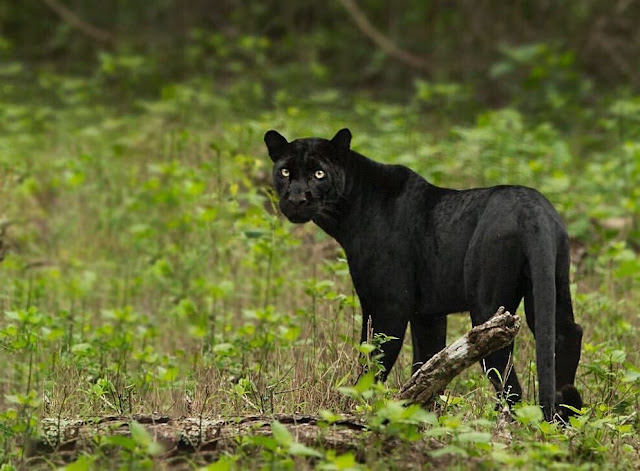 |
| Black Panther Sightings At Kabini |
Different Areas in the Park
The park is located in a place where the Deccan plateau joins with the Western Ghats. The park’s altitude ranges from 680m to 1,454m.
North – This region is bordered by Kabini river. This is the main water source of the park and many mammals can be spotted near the banks. The region receives heavy rainfall and is covered with forest. Moist deciduous forest are common here. Large herbivores are spotted easily.
South East – This part of the park is dry and excellent spot for finding predators and also for birdwatching.
Center – This region is famous for the Kabini backwaters. It is the best spot for finding elephants and other wildlife. Gaur and deers are common here.
West – This region is covered with mountains, streams, waterfalls and valleys. Bamboos and sandalwoods are common in this region. Tree dwelling animals can be easily spotted here.
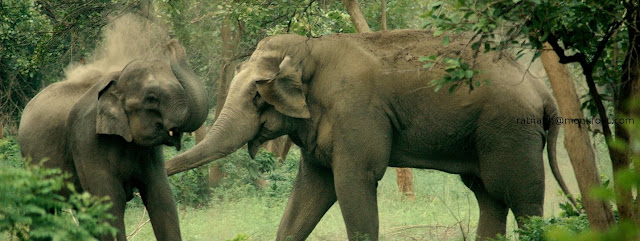 |
| Elephants at Nagarhole National Park |
Flora of Nagarhole National Park
The Northern part of Western Ghats form a predominate region in the park. This region is filled with moist deciduous forests. Rosewood and teakwood are found very common in the southern part of the park. In the central part of the park, dry deciduous forests are found. Pala indigo is very common here. In the swamp regions, Eugenia trees are very common.
Other main trees found in this park are silver oak, sandalwood, teak, crocodile bark, Indian kino tree, axle wood, kadam, cotton tree, ficus, beechwood, Indian gooseberry and others. Top conspicuous tree species are clumping bamboo, flame of the forest and golden shower tree.
Fauna of Nagarhole National Park
Top animals to spot here are Bengal tiger, leopard, sloth bear, ussuri dhole, antelope, barking beer, sambar deer and elephant. You can find many jungle bison here. In places where bamboo trees are found, elephants are very common. Other common animals to spot are jungle cat, leopard cat, gray langur, civet, mongoose, bonnet macaque, Indian giant flying squirrel, hare, pangolin and others.
Nagarhole national park is famous for birdwatching too. More than 250 species of birds are found here. The birds are commonly found near the KabiniRiver. Top birds to spot are blue bearded bee-eater, Malabar whistling thrush, common osprey, duck and herons.
The park is an important bird watching spot during summer season. The artificial lakes and rivers dry into puddles, which attract many birds. Top birds to spot are white backed vulture, greater spotted eagle, Nilgiri wood pigeon, red headed vulture, blue winged parakeet, oriental white ibis, Malabar grey hornbill and others. In the dry region of the park, top birds to spot are painted bush quail, ashy prinia, Indian robin, yellow-legged green pigeon, Indian peafowl and others.
Top reptiles found in the park are muggers, common vine snake, bamboo pit viper, Indian rock python, Indian monitor lizard, common wolf snake and others. There are 96 species of dung beetles and more than 60 species of ants in the park. Most interesting ant species in the park is the jumping ant, which can jump up to one meter high.
Climate of Nagarhole National Park
Summer : Summer starts in March and ends in May. The temperature can go higher than 30-degree C. Dehydration during trekking and other activities is very common in this season. During the summer, the artificial lake dries into puddles of water. This attracts manybirds, which feed on fishes in the puddles of water. Excellent time for birdwatching.
Monsoon : Monsoon stretches from June to September. The place receives heavy rainfall. Leeches are common in this season. Thus, keep caution while enjoying safari. The land becomes mushy and sticky during rainy season making transportation, harder. Certain safaris might be temporarily stopped during this season and certain regions would be blocked for entry.
Winter : Winter starts in November and ends in January. The temperature can go as low as 14 degree C. Migration birds are common during this season.
Best Season to Visit Nagarhole National Park
The best time to visit is from October to May. During this period, spotting animals and birds is easy. Travel within the park is also easier. It is better to avoid monsoon season. During heavy rain, the park might be closed for visitors.
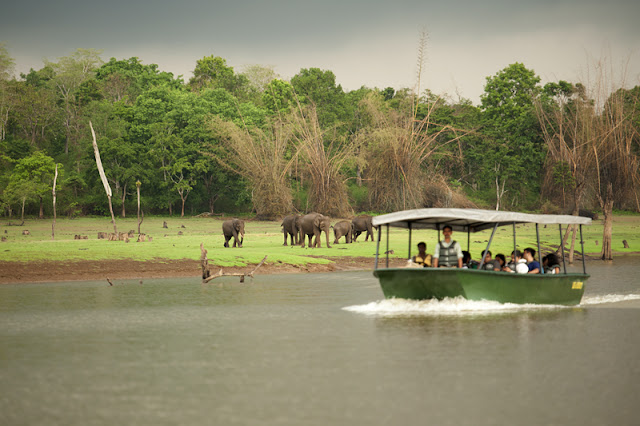 |
| Boat Safari At Kabini National Park |
Wildlife Safari in Nagarhole National Park
Nagarhole national park provides many different types of safari experience.
Jeep safari is the best for spotting large herbivores and predators. Top animals to spot during a jeep safari are leopard, elephant, tiger and others.
Boat safari is available on the river Rabini. This safari is the best to spot aquatic wildlife like water birds, crocodile and others. Coracle ride is also available in the river. Coracle is an Indian round boat that is best for slow drifting. During the ride, the coracle is kept along the river to spot land animals too.
Bus safari is available in the morning and evening. The possibility of spotting animals is higher with the bus. The bus fee is 150 INR per head. 16-20 people can travel in a bus. During peak season, the route of the bus would be shortened to avoid long queue.
Book Online Kabini Safari
Wildlife Safari Timings
Jeep safari : from 5:30 am to 10:00 am and, from 3:00 pm to 7:00 pm
Coracle ride : from 9 am to 11 am and, from 5 pm to 6 pm
Bus safari : 6 am to 9 am and, from 3 pm to 5 pm
How to Reach Nagarhole National Park
The nearest airports are located in Mysore and Bangalore. Bangalore is the nearest international airport to the park. It is located 236 km away from Nagarhole national park. Mysore airport is located just 96 km from the park. Tourists usually enter India via Bangalore airport and then take up a connecting flight to Mysore. From Mysore airport, a lot of cabs, buses and other transportations are available to reach Nagarhole national park.
The nearest railway station is located in Mysore. The railway station is just 80 km away from the Nagarhole national park. There are train services from various parts of the country to Mysore. From the railway station, one can hire cab or bus to reach the park.
Buses to Nagarhole national park are available from Mysore, Bangalore, Madikere and others. Taxi services are also available. A taxi ride from Bangalore to the park would cost around INR 5,000 and from Mysore, the cost is approximately 2000 INR.
Why Wildtrails
Distance between major cities and Nagarhole National Park
- Madikere and Nagarhole national park – 90 km
- Mysore and Nagarhole national park – 80 km
- Bangalore and Nagarhole national park – 220 km
- Coorg and Nagarhole national park – 75 km
- Coimbatore and Nagarhole national park – 288 km
- Palakkad and Nagarhole national park – 235 km
- Kutta and Nagarhole national park – 10 km
